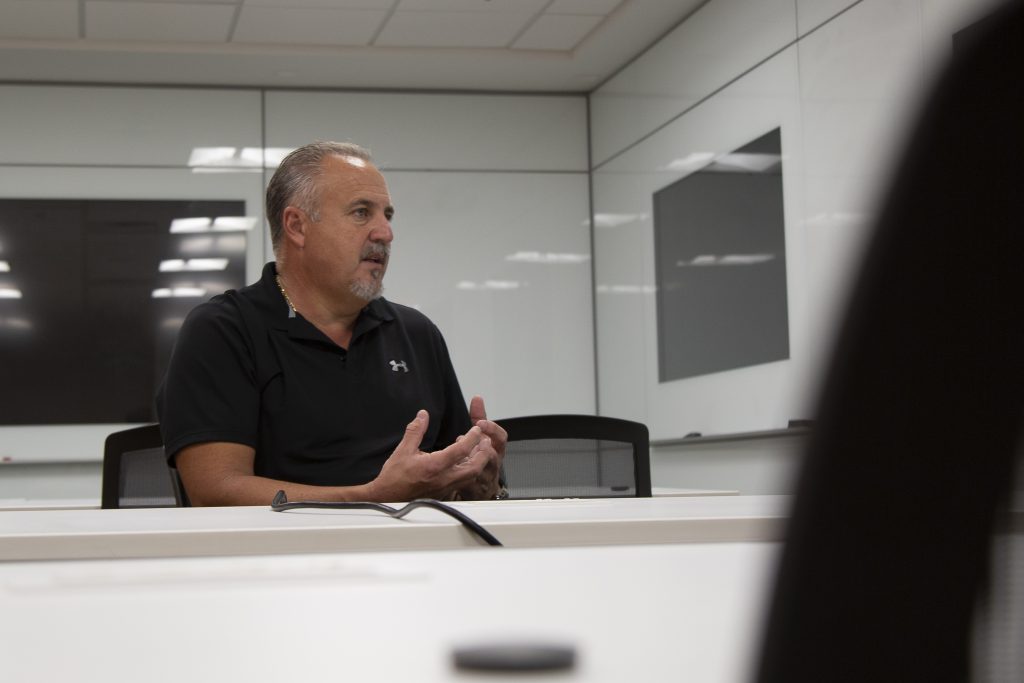Shooter drills incite debate over how to secure our schools
By Marcus Callegari
Christopher Columbus High School
For teacher Eric Garner, returning to Marjory Stoneman Douglas High School after a shooting that killed 17 students already felt like returning to a crime scene.
Now, going through constant active shooter drills only serves as a reminder of those he lost that day.
“It’s somewhat of a necessary evil. I don’t know how we can avoid it and I think it would be wrong to try to avoid it,” Garner said. “We got to do it, get it done, keep moving.”
Garner has lived through a traumatic shooting, and he believes that the way to prevent the reality of another active shooter is with preparation.

(Photo by Abigail Tuschman)
Last year, 114 people were either killed or injured in school shootings in the United States, according to Education Week’s school shooting tracker. These numbers have put school boards in a national state of panic as they try to ensure that their students and teachers are properly trained on how to handle an attack.
The Marjory Stoneman Douglas High School Public Safety Act was signed on March 9, 2019, and a part of this law requires active shooter training in schools once a semester. But although these drills are meant to protect students, they might be damaging their mental health instead.
Communities are beginning to question whether active shooter training is the best way to prepare students for possible disaster. Alissa Alfonso’s daughter Goldie is a student at Beachside Montessori Village K-8 in Homestead. Alfonso said that the drills are scaring children with the threat of death, even if they are preparing them for emergency.
“I do feel like they run through it so there’s a plan in place, but I also feel that it’s just too much, it’s overload,” Alfonso said. “Every single month there’s something going on and I feel that it’s scaring our children.
Thoughts like these may keep students on high alert for surprise drills. Grace Tejada, a rising senior at G. Holmes Braddock Senior High, and has been exposed to these active shooter drills for all three years of her high school experience.
Tejada described how her school administrators simulate an unlucky student who is left outside in the hall during a drill.
After the students lock themselves in, the administrators walk through the halls, banging on doors and yelling for help, teaching students to keep doors shut. Tejada, along with many of her classmates, despises the idea of having to abandon a friend for dead.
“Just imagining what the situation would be like if it were to be real is pretty unsettling,” Tejada said. “To think that I would have to leave a fellow classmate outside, just because we’re not allowed to open the doors.”
Much of this fear stems from training that is carried out by uninformed administrators. Daniel Villanueva, former marine and owner of a security consulting company, teaches his clients that education and prevention is more effective than traumatizing students.
“I’m against [these physical simulations of shootings]. I’m all for training the teachers, the administration, and basically talking to the students, not to traumatize them, but to assure them that we’re ready,” Villanueva said.
Despite some professionals taking issue with active shooter drills, others believe that they efficiently ensure safety.
Laura Mazo, 18, a recent graduate of TERRA Environmental Research Institute, believes the drills are helpful and keep students safe.
“I do feel that the drills are helpful, and due to this, I feel that it’s gotten to the point where the kids are comfortable with how many drills we’ve done,” Mazo said. “Of course, I believe that teachers and counselors should be open to the idea of kids discussing possible alternatives with them.”
The students’ conflicting views on active shooter drills aren’t without reason.
Dr. Ted Wasserman, a pediatric neuropsychologist, believes that not all students are affected by active shooter drills in the same way.
“It’s hard to say whether they are good or bad just from the psychological reaction, but it’s safe to say that some kids will be affected more than others,” Wasserman said. “This is due to what type of preparation they receive.”
These opposing opinions raise questions about what the general population wants out of these drills.
As a survivor of a shooting, Garner said crisis preparation methods must be continually improved.
“That’s the advice I would give at the end of the day about this. We just have to keep moving.”